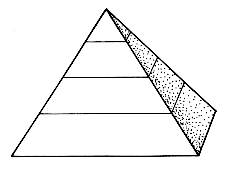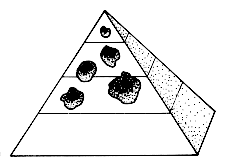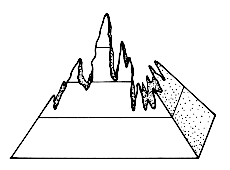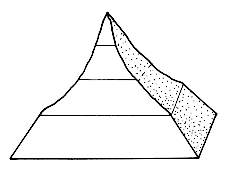
Unfished ecosystem
The largest group of tables in FishBase is related to the trophic ecology of fishes and presents information on habitat, food items, diet composition, food consumption and predators of various fish species. The broad ‘ECOLOGY table’ of Froese et al. (1992) also covered environmental tolerance and behavior, but only few suitably standardized datasets were found and such information previously entered is now made accessible in the Remarks field of the SPECIES table, and in several fields (temp., pH, and H) in the STOCKS table.
The information on trophic ecology, which can be used for construction of Ecopath models (see Box 21), is presented in the following tables:

Single species management
The ECOLOGY table presents information on the environment, e.g., the body of water which the species inhabits, and its feeding habits (incl. trophic levels);
The FOOD ITEMS table lists organisms that have been found in the stomach or are otherwise known to be ingested by a given species;
The DIET table gives the percentages (in weight or volume) of the different types of food item reported from studies of stomach contents;
The RATION table presents the daily food intake relative to the body weight of the fish sampled, and related parameters;

No management
The POPQB table gives the annual food consumption (Q) per unit biomass (B) of a fish population and the population dynamics parameters used in its estimation;
The PREDATORS table documents instances of a predator (not necessarily a fish) having consumed fish of a given species.

Ecosystem management
Also, a multi-level structure was created for these tables, which describes food items in increasing level of detail, from the Foods I field (consisting of 6 different broad food types, presented through a multiple choice field) and the Food II field (22 food types) to the Food III field (55 food types). This structure, which distinguishes stages (for both plants and animals), also allows entry of details on a given food item (e.g., name of the species ingested). Box 24 of the FOOD ITEMS table provides more detail on this as well as the trophic levels assigned to the different items in Foods I, II, and III, while Box 25 describes the method used to obtain estimates of trophic levels in fish whose diet composition is known. The FOOD ITEMS table provides more detail on this structure, as well as the trophic levels assigned to the different items which can be used to estimate trophic levels in fish whose diet composition is known.
Developed in the early 1980s by J.J. Polovina and co-workers at the NMFS Laboratory in Honolulu, and first applied to a coral reef system north of Hawaii (Polovina 1984), the Ecopath approach for the construction and analysis of mass-balance trophic models of ecosystems was further developed by the authors. Particularly, we extended it to include a wide range of analytic routines, and encouraged its application to a variety of systems (Christensen and Pauly 1992, 1993; Pauly and Christensen 1993; Christensen and Pauly 1995). The Ecopath approach consists of the following steps:
Define the area (ecosystem), and period to be modeled, and functional groups (i.e., ‘boxes’, or state variables) to be included in the model (these definitions depend mainly on the density of available data);
For each functional group (i), obtain preliminary estimates of all but one of the parameters of the Ecopath master equation: Bi · (P/B)i · EEi = Yi + å Bj · (Q/B)j · DCij, where Bi and Bj are the biomasses of i and of its consumers j, respectively; P/Bi the production/biomass ratio (i.e., the mortality of i (Allen 1971); EEi the fraction of i’s production (P= Bi(P/B)) that is consumed within the system; Yi the fisheries catches; Q/Bj the relative food consumption; and DCij expresses the fraction of i in the diet of j;
Use the various routines of Ecopath to solve the system of linear equations in (2) for the entire system; and
Use the network of flows defined by this system of equations to derive statistics such as trophic levels (see Box 23) transfer efficiencies, niche selection indices, natural mortality estimates (see POPGROWTH table), etc.
Ecopath and FishBase have a number of common characteristics, notably their goal of bridging the gaps between fisheries science and related disciplines; their wide availability; a vast network of users and collaborators; and through these, the provision of standards for their respective disciplines: ecosystem modeling, in the case of Ecopath: applied ichthyology in the case of FishBase.
However, the relationships between Ecopath and FishBase extend far beyond this. As an example, the trophic levels now incorporated in FishBase, and the analytic routine linking them with the FAO CATCHES are derived from Ecopath applications (see Pauly and Christensen 1995). Conversely, the entries in the TROPHIC ECOLOGY tables of FishBase are largely meant to assist Ecopath users in deriving preliminary estimates of the Q/B and DC parameters of the system of equations in (2) above; while the M values in the POPGROWTH table provide estimates of P/B in unexploited fish stocks. Readers’ suggestions on this and related topics may be sent to FishBase (
fishbase@cgiar.org), or to Villy Christensen (v.christensen@fisheries.ubc.ca), who maintains Ecopath. See also the Ecopath homepage (www.ecopath.org), from which the latest update of Ecopath can be downloaded free of charge, and various information obtained on its application and dissemination.
References
Allen, K.R. 1971. Relation between biomass and production. J.
Fish. Res. Board Can. 28: 1573-1881 Christensen, V. and D. Pauly. 1992. Ecopath II - a software for
balancing steady-state ecosystem models and calculating network characteristics.
Ecol. Modelling 61(3/4):169-185. Christensen, V. and D. Pauly, Editors. 1993. Trophic models of
aquatic ecosystems. ICLARM Conf. Proc. 26, 390 p. Christensen, V. and D. Pauly. 1995. Fish production, catches
and the carrying capacity of the world oceans. Naga, ICLARM Q. 18(3):34-40. Pauly, D. and V. Christensen. 1993. Stratified models of large
marine ecosystems: a general approach and an application to the South China Sea,
p. 148-174. In K. Sherman, L.M. Alexander and B.D. Gold (eds.) Large
marine ecosystems: stress, mitigation and sustainability. AAAS Publication,
Washington, DC. 376 p. Pauly, D. and V. Christensen. 1995. Primary production required
to sustain global fisheries. Nature 374:255-257. Polovina, J.J. 1984. Model of a coral reef ecosystem. I. The
Ecopath model and its application to French Frigate Shoals. Coral Reefs
3(1):1-11. Daniel Pauly and Villy Christensen
In order to improve FishBase output for ecosystem modeling, a new routine was created to construct a simple representation of the trophic structure of an ecosystem. This draws on data in the ECOLOGY table and employs the concept presented by Lindeman (1942; see Box 28).
You get to the suite of TROPHIC ECOLOGY routines through the Biology button in the SPECIES window and the Trophic Ecology button in the BIOLOGY window.
On the Internet, you find the various TROPHIC ECOLOGY tables in the ‘More information’ section of the ‘Species Summary’ page. Alternatively, you can create lists of species with available data on e.g., Diet or Ration by clicking on the respective radio button in the ‘Information by Topic’ section of the ‘Search FishBase’ page. In that section, you also find radio button for Ecopath parameters and Trophic pyramids.
Many thanks to Pascualita Sa-a for suggesting numerous improvements to the Diet Composition table, and R. Froese for his interest in and support of trophic ecology as a component of FishBase.
Froese, R., M.L.D. Palomares and D. Pauly. 1992. Draft user’s manual of FishBase, a biological database on fish. (ver. 1.0). ICLARM Software 7, pag. var.
Maria Lourdes D. Palomares and Daniel Pauly